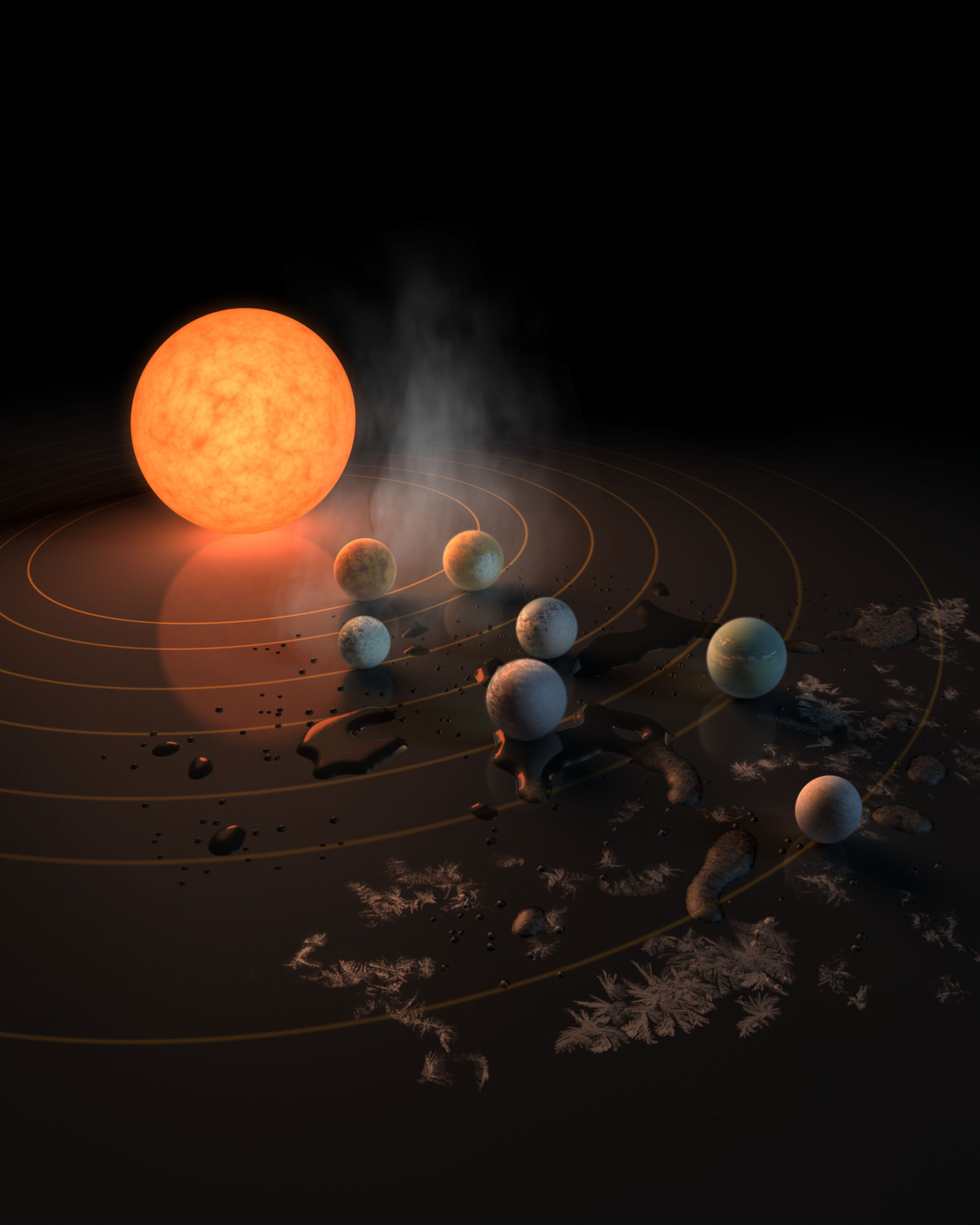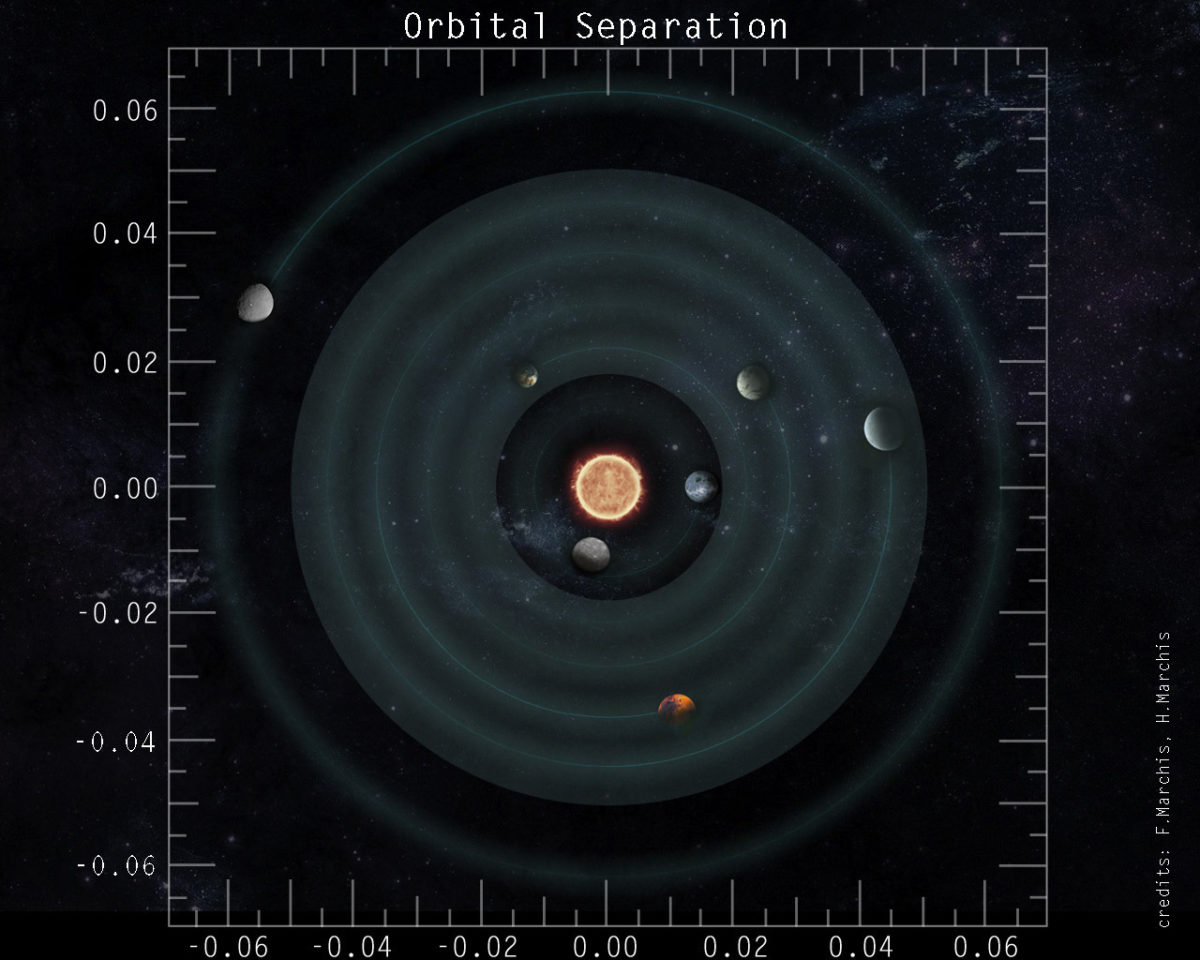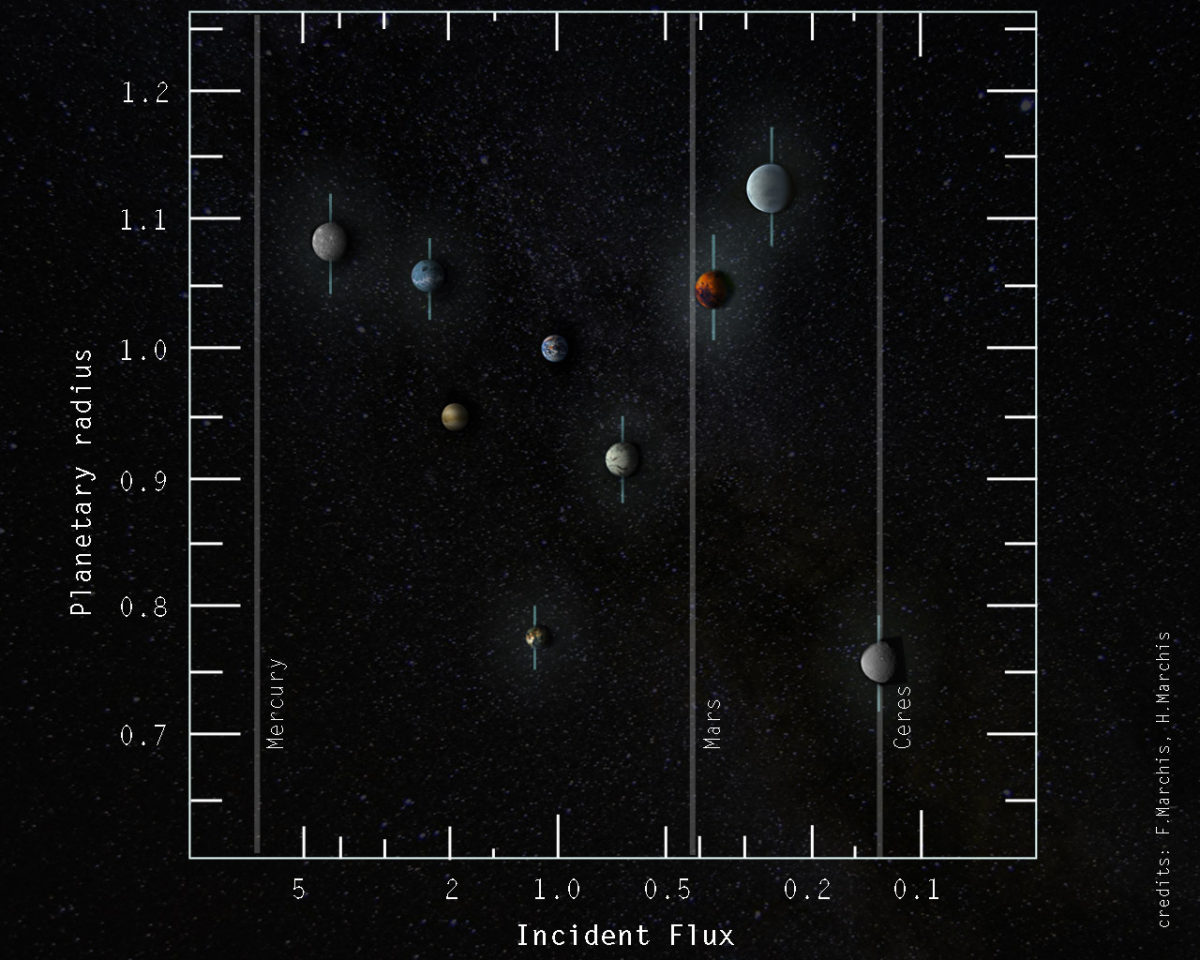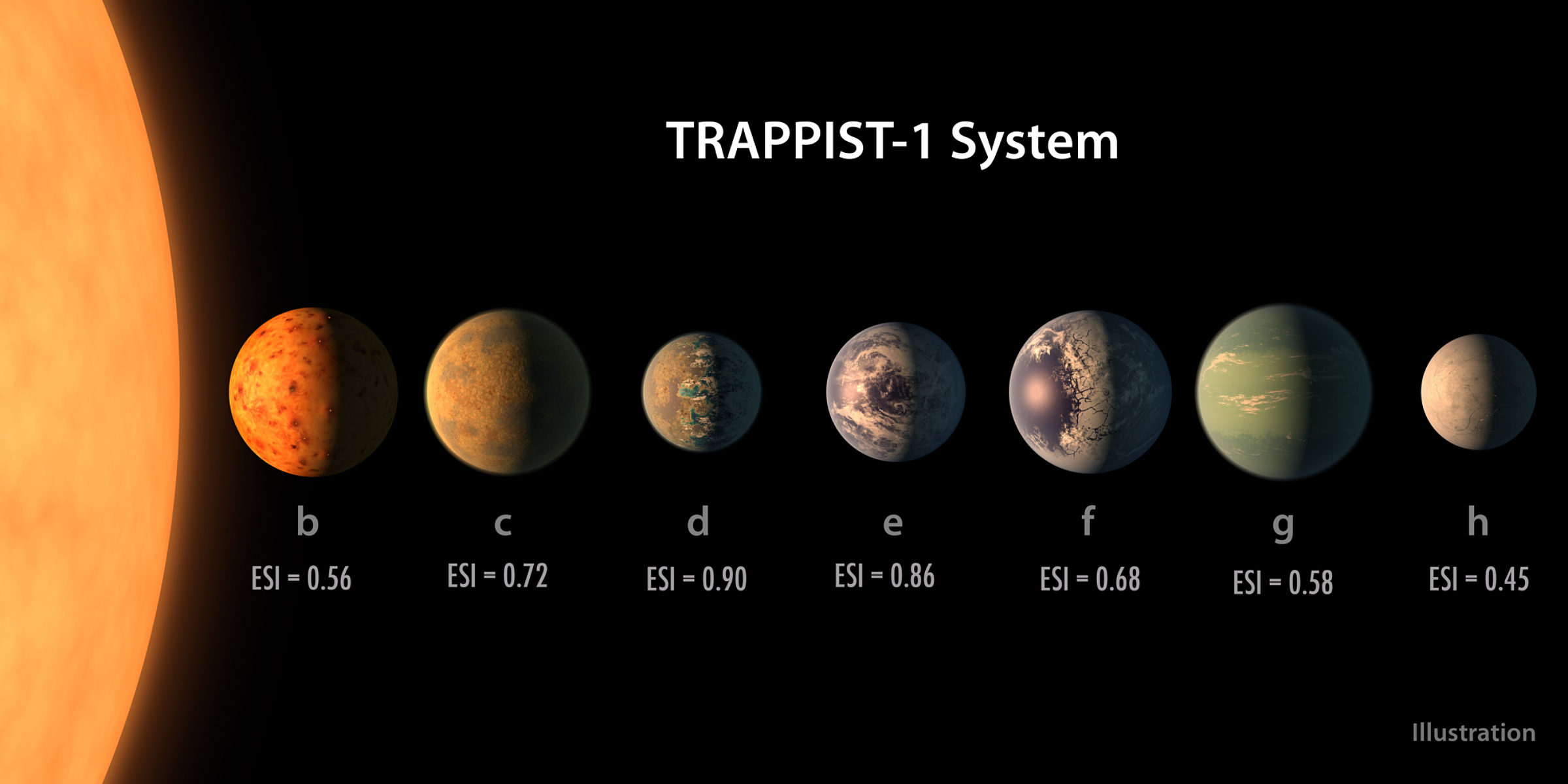Franck Marchis • Feb 22, 2017
Wonderful potentially habitable worlds around TRAPPIST-1
This post originally appeared on Franck Marchis' Cosmic Diary blog and is reposted here with his permission.
In May 2016, Michael Gillon and his team announced the discovery of three Earth-sized exoplanets around TRAPPIST-1, an ultra cool M-dwarf star, using the small TRAPPIST telescope at ESO-La Silla, Chile. It was an exciting discovery—yet on that day no one could possibly have imagined that less than a year later they would make another significant discovery involving the same system. But here we are: today, they announced in Nature the discovery of seven potentially habitable Earth-like worlds.

The star, named TRAPPIST-1, is a fairly inconspicuous star in our Milky Way. Small (8% the mass of the sun) and cold (half the temperature of the sun), it is a member of an ultra-cool dwarf population that represents 15% of the star population of our galaxy. In 2016, Gillon and his team detected the transit (i.e., the shadow of a planet passing between its host star and us) of three exoplanets at the inner edge of the habitable zone of their star.
Energized and excited by this discovery, the team requested and received additional telescope time to follow up on this system during the second half of 2016. The NASA Spitzer telescope is one of the facilities they selected for an ambitious program that called for monitoring the TRAPPIST-1 system almost continuously for twenty days. Spitzer and other ground-based telescopes allowed the team to detect thirty-four transits, more than they had anticipated, suggesting the existence of additional exoplanets in the system.
After an careful analysis, the data revealed the presence of seven Earth-sized exoplanets (named TRAPPIST 1b, c, d, e, f, g, and h) in orbit around this M-type star. Because their orbital periods are short (less than twelve days for planets b to g), several transits were detected during the campaign. Accurately measurements of those tiny events (0.6% dimming of the star) provide a wealth of information about the planets’ orbits, sizes, and even masses by measuring precisely the timings of the transits which are perturbed by the gravity of other planets.

So what have we learned about the TRAPPIST-1 system?
- It’s very tight; the most distant planet (h) is at 0.06 AU from its star. The closest one is at 0.01 AU. For comparison, Mercury orbits at 0.39 AU from our sun. This is NOT equivalent to our solar system, but more a minuscule version of it, comparable in size/mass ratio to Jupiter and its Galilean Moons.
- Similar to our solar system, these exoplanets travel circular orbits all of which go in the same direction. They probably formed more than 500 million years ago together with their star.
- The depth of the transits provides a measurement of the radius of the planets, which are similar to Earth (b, c, e, f, g) or Mars (d, h) so they range from 75% to 110% the size of Earth.
- The data are accurate enough to detect mutual gravitational effects, so we can infer the mass of the first six planets, and hence their density. Those are rocky worlds that range in density from 60 and 117% that of Earth.
- Considering the amount of energy they receive from the star, these planets might have a temperature suitable for the presence of liquid water on their surface (e,f,g) if we assume a similar atmosphere than Earth.

What can’t we say about the TRAPPIST-1 system?
- This is not the first discovery of a system with this many exoplanets. HR8832 and HD10180 have seven planets that were discovered by radial velocity. In both cases, the exoplanets are massive, at least ten times the mass of Earth. The host stars also have a mass similar to our sun. Kepler-90 is another system with seven exoplanets discovered by transit measurements. Several of those exoplanets are larger than Earth and probably ice and gas giants. What is crucial here is that for the first time, we have discovered seven temperate rocky exoplanets in orbit around a M-dwarf star. There are many such stars in our galaxy, so there are probably a lot of worlds like these out there!
- No, we have not yet discovered a cousin of Earth, much less seven of them. The measurements provide interesting information about these exoplanets, and we can confidently say that six of them are rocky. However, their location in the habitable zone of their star does not imply that they are habitable. For instance, Mars and Venus are in the habitable zone of our Sun, but are not habitable anymore. In other words, it is too early to say if there are oceans on their surface. TRAPPIST-1 is located about forty light-years from us, so we will probably need the large aperture of the JWST or a dedicated space telescope like ARIEL to detect the presence of an atmosphere and derive its composition. Using the Hubble Space Telescope, the team has tried to detect an exosphere on one of the planets but without success so far.
- No, we have not detected life on those exoworlds. In my opinion, life is the result of a complex cascade of random events, and we don’t really know if those exoplanets, located near an ultra-cool star, are suitable for life. They are very close to their star and may be tidally locked, showing the same hemisphere to their star at all times. The existence of life on worlds with temperatures that vary from one hemisphere to the other is difficult to imagine. It will take years of observations and modeling to understand if life can exit on such a strange worlds.

Last year, astronomers announced the discovery of a potentially terrestrial planet around Proxima Centauri, located only 4.2 light-years away from us. Today, this group reveals the existence of seven potentially habitable worlds around a small star that could live forever. The field of exoplanet is without doubt booming, and it is not over.
A team led by Emmanuel Jehin, co-author of the paper, is currently building Speculoos, a TRAPPIST telescope “on steroids”, made of four, 1-meter robotic telescopes installed at Cerro Paranal. With this telescope, the team will survey 10 times more red dwarfs than TRAPPIST did. So we could expect the discovery of a dozen systems similar to this one soon. We will have the opportunity to explore the diversity of atmospheres and climates on Earth-like worlds, and potentially life out there.
The discovery of these strange new worlds where life could flourish is the beginning of an exciting time for astronomers and biologists. A time when we are beginning to see the unimaginable, a time when life as we don’t know it can be imaged and studied. We will probably need to build complex and expensive instruments to understand those worlds—but what an astonishing, awe-inspiring, life-changing prize to win, don’t you think?
Let’s Go Beyond The Horizon
Every success in space exploration is the result of the community of space enthusiasts, like you, who believe it is important. You can help usher in the next great era of space exploration with your gift today.
Donate Today

 Explore Worlds
Explore Worlds Find Life
Find Life Defend Earth
Defend Earth

